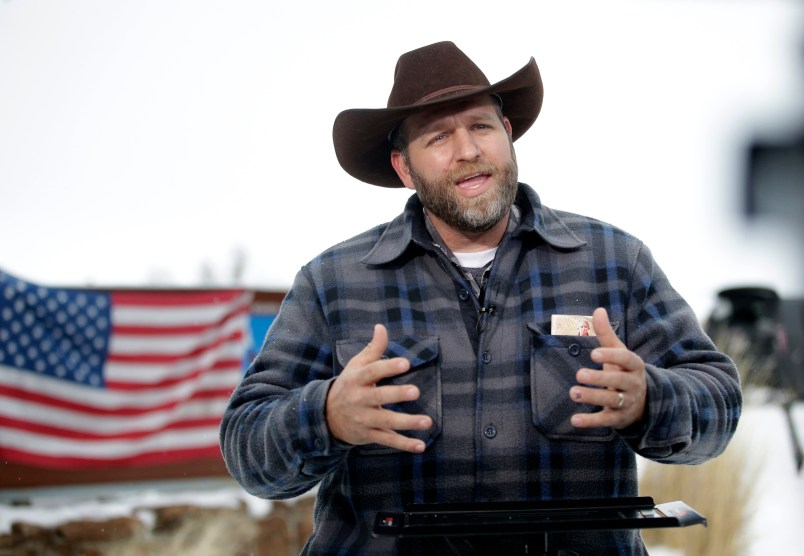In many ways, the fight the Bundy brothers and their associates are picking with the federal government by occupying a wildlife refuge in Oregon is more or less a sequel to the showdown at their father Cliven Bundy’s Nevada ranch two years ago.
The bulk of their grievances revolve around what they believe is a federal overreach in the management of public lands. But the ideas they promote are not original to them. They appear to be hodgepodge of long-held theories of the hard right, particularly in the rural West, including the Sagebrush rebellion, the Wise Use agenda and the Posse Comitatus movement.
“They’re looking around and they’re borrowing and taking what sounds right to them,” Mark Pitcavage, the director of investigative research for the Anti-Defamation League, told TPM.
Tension between the federal government and ranchers like the Bundys have existed for as long as they have sought to use public land for grazing and other needs. The Bundys and their crew believe that the federal government has unconstitutionally claimed land owed to the citizens, and that land should be controlled. Pitcavage called his claim “erroneous,” arguing that vast expanses of federal land in the West — acquired in transactions like the Louisiana Purchase –has been under the U.S. government’s jurisdiction since before states were in existence.
Nevertheless, the Bundys and their associates have made their main demand that the government give over that land to local control.
“When Harney County residents are safe in the use of their resources, when Oregon is safe from the threat and intimidation of a central power … that is the broad plan,” LaVoy Finicum — a Nevada rancher who had embraced the Bundys’ campaign against the feds even before he joined the siege — told reporters.
The current dispute has been compared to the Sagebrush rebellion, the push in the 1970s and 1980s to give states control of the public land in the West that is under federal jurisdiction. It also touches upon the “Wise Use agenda” that evolved out of the Sagebrush rebellion and gained steam in the late 1980s. Wise Use activists pushed back against environmental regulations and advocated that public lands be available for private use without restrictions.
“The Wise Use movement got a lot of conservative support in the 1990s and 2000s — including mainstream support,” Pitcavage said. “The energy petered out, but the ideas did not.”
Pitcavage pointed out that one of the attendees with the Bundys at a meeting in March with Nevada legislators about the feds’ management of public lands in the state was Wayne Hage. His father was Nevada rancher E. Wayne Hage, who wrote 1989’s “Storm over Rangelands: Private Rights in Federal Lands,” which inspired the Wise Use movement.
The language coming out of the Malheur Wildlife Refuge this week is not that different from what Cliven Bundy was saying two years ago in Nevada.
“This is the same line of rhetoric they’ve been saying basically since their disagreement with the federal government started,” Ryan Lenz, senior writer for the Southern Poverty Law Center’s Intelligence Project, told TPM.
But rhetoric driving the siege extends beyond this central dispute over land. The Bundys and their supporters have repeatedly called upon local authorities to defend Dwight Hammond, Jr., and his son Steve Hammond from the federal jail sentence they face for burning public land, which is what prompted the protest that preceded the siege.
“We have spent several weeks, two months to be exact, in petitioning the state and the local county representatives to stand for the Hammonds against these unconstitutional actions,” Ammon Bundy said at a Tuesday press conference. He added that the occupiers had also asked the local sheriff to intervene in the Hammond case.
The idea that local sheriffs should protect their constituents from federal government actions perceived to be unconstitutional recalls a movement known as “Posse Comitatus,” which is Latin for “force of the county.”
In the late 1960s and early 1970, Posse Comitatus became the name for a hard right organization that resisted federal control in favor of local authority. It in turn gave rise to the extremist “sovereign citizen” movement.
“Other people on the extreme right have had this notion that sheriffs can protect people from the federal government, other than sovereign citizens,” Pitcavage said. “I don’t think the Bundys got the idea from sovereign citizens, but you can see that’s another idea they got from somewhere and absorbed and included with their other beliefs.”
These ideas animated the 2014 Bundy ranch showdown, but some believe that the federal government’s failure to bring criminal charges against the Bundys after that standoff –or even collect the $1 million they owe in grazing fees — further emboldened the movement.
“The rhetoric has existed long before the Bundys brought it to the forefront in 2014. But since 2014, due to federal inaction, that rhetoric is now accepted as legitimate truth,” Lenz said.










